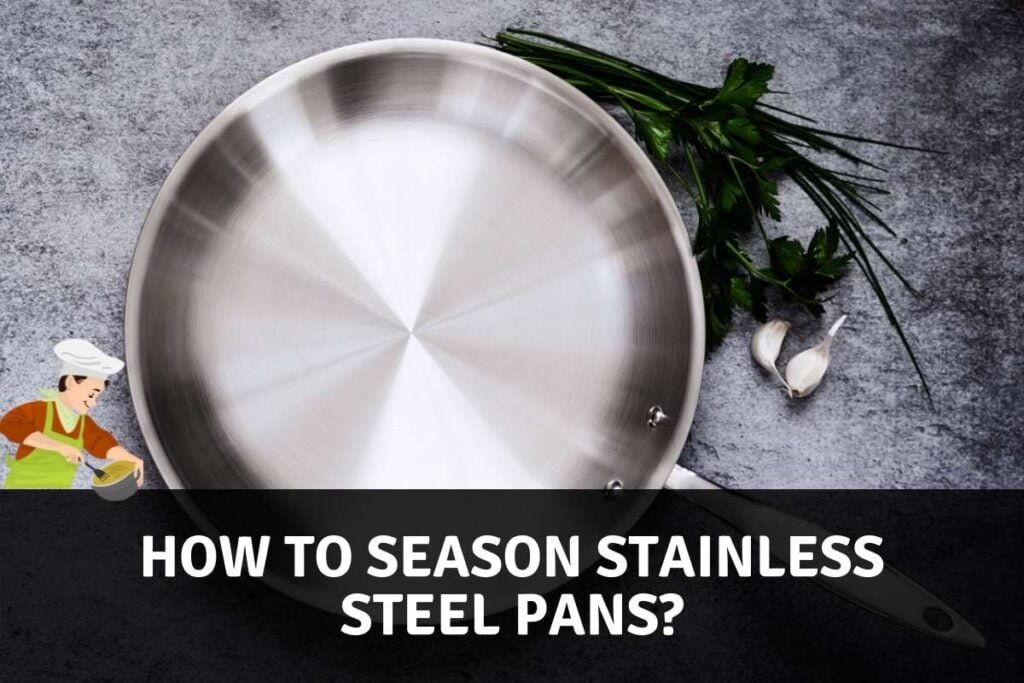As an Amazon Associate BakingBakewareSets.com earns from qualifying purchases.
How to Season Stainless Steel Pans: Guide for Home Cooks
Have you ever wondered how to season stainless steel pans?
If you’re like many home cooks and kitchen enthusiasts, you’ve probably struggled with food sticking to your stainless steel pans, or perhaps you’re looking to enhance their non-stick properties. Seasoning stainless steel pan could be the solution you’ve been seeking, but how exactly does one do it?
Here’s the answer: Seasoning a stainless steel pan involves applying a thin layer of oil with a high smoke point, heating the pan, and then letting it cool. This simple process helps create a non-stick coating, making your stainless steel pan perfect for cooking.
Interested in making your stainless steel pan non-stick? Wondering how to season stainless steel pan with coconut oil or in the oven? Then you’re in the right place. As a seasoned cook who’s worked with all kinds of stainless steel cookware, I can guide you through the process, covering everything from seasoning stainless steel pan with salt to proper stainless steel care. In this comprehensive guide, I’ll not only answer the question, “Are you supposed to season a stainless steel pan?” but also provide expert insights and tips to help you achieve the perfect seasoned stainless steel pan. Read on, and let’s take your cooking to the next level!
Key Facts:
(Source: Expert Team Research)
- Seasoning a stainless steel pan improves its non-stick performance.
- High smoke point oils are best for seasoning.
- Proper heating and cooling techniques are vital.
- Seasoning stainless steel pan with coconut oil is possible.
- Regular maintenance ensures a longer-lasting seasoning.
How to Season Stainless Steel Pans: A Step-by-Step Guide

1. Preparing Your Stainless Steel Pan
Cleaning the Pan Thoroughly
Clean the pan with warm water and gentle dish soap, then dry it completely. This will remove any residues and make sure the oil adheres properly.
Selecting the Right Oil with a High Smoke Point
Choose an oil with a high smoke point, such as vegetable oil, peanut oil, or grapeseed oil. This ensures that the oil won’t burn and will create a durable non-stick layer.
2. Applying the Oil
Methods to Apply Oil Evenly
You can use a paper towel or lint-free cloth to spread the oil around the surface of the pan. It should be a thin, even layer.
Importance of Using Lint-Free Cloth or Paper Towel
A lint-free cloth or paper towel ensures that no fibers are left behind on the pan, which could interfere with the seasoning process.
3. Heating the Pan
How to Heat the Pan to the Right Temperature
Preheat the pan on medium-high heat until the oil starts to smoke. This indicates that the oil is polymerizing, forming the non-stick layer.
Ensuring Not to Overheat
Be mindful of not overheating the pan, as this could cause the oil to burn and ruin the seasoning.
4. Cooling and Wiping the Pan
Proper Cooling Techniques
Allow the pan to cool completely. This helps the non-stick layer to harden.
Wiping Away Excess Oil
Use a paper towel to wipe away any excess oil, leaving a thin, even coating.
5. Repeating the Process
How Many Times to Repeat the Process
You may want to repeat the process 2-3 times to create a robust non-stick layer.
When to Re-Season the Pan
Regularly check the pan’s surface. If you notice a decrease in non-stick performance, it may be time to re-season.
Tips and Tricks for Seasoning Stainless Steel Pan
Using Coconut Oil
How to Season Stainless Steel Pan with Coconut Oil
Follow the same process as above, but use coconut oil. It adds a unique flavor and can create an effective non-stick layer.
In the Oven
How to Season Stainless Steel Pan in the Oven
You can also season the pan in the oven at 350°F. Simply follow the same oil application process, then bake for an hour.
Proper Maintenance
How Often to Season Stainless Steel Pan
Re-season as needed, depending on how frequently you use the pan and what you’re cooking.
Cleaning and Storing
Avoid using harsh scrubbers or soaps that could damage the seasoning. Store in a dry place.
Common Mistakes to Avoid During Seasoning Stainless Steel Pan in Oven
Using the Wrong Oil
Oils with low smoke points can burn easily. Always choose oils with high smoke points for seasoning.
Overheating the Pan
Excessive heat can burn the oil and ruin the seasoning.
Incomplete Cleaning
Leaving residues or detergents on the pan before seasoning can prevent the oil from adhering properly.
FAQs About How to Season Stainless Steel Pan
Are you supposed to season a stainless steel pan?
Yes, seasoning a stainless steel pan enhances its non-stick properties, although it’s not required.
Should you add oil to stainless steel pans before or after heat?
You should add oil before heating the pan to ensure an even coating.
How do you keep stainless steel cookware from sticking?
Seasoning the pan and using the proper cooking techniques can prevent sticking.
How to make stainless steel pan non-stick?
Seasoning the pan by applying a thin layer of high smoke point oil and heating it properly creates a non-stick surface.
Summary
Seasoning a stainless steel pan is an effective way to enhance its non-stick properties. By following the correct steps and using the right oil, you can make your stainless steel pan a versatile tool in your kitchen. Remember, the key to a perfect seasoned stainless steel pan lies in proper preparation, heating, and maintenance. So, are you ready to take your cooking to the next level with a well-seasoned stainless steel pan? Enjoy the process, and happy cooking!


